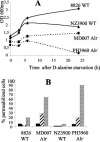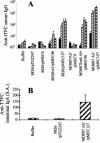Enhanced mucosal delivery of antigen with cell wall mutants of lactic acid bacteria
- PMID: 15102782
- PMCID: PMC387887
- DOI: 10.1128/IAI.72.5.2731-2737.2004
Enhanced mucosal delivery of antigen with cell wall mutants of lactic acid bacteria
Abstract
The potential of recombinant lactic acid bacteria (LAB) to deliver heterologous antigens to the immune system and to induce protective immunity has been best demonstrated by using the C subunit of tetanus toxin (TTFC) as a model antigen. Two types of LAB carriers have mainly been used, Lactobacillus plantarum and Lactococcus lactis, which differ substantially in their abilities to resist passage through the stomach and to persist in the mouse gastrointestinal tract. Here we analyzed the effect of a deficiency in alanine racemase, an enzyme that participates in cell wall synthesis, in each of these bacterial carriers. Recombinant wild-type and mutant strains of L. plantarum NCIMB8826 and L. lactis MG1363 producing TTFC intracellularly were constructed and used in mouse immunization experiments. Remarkably, we observed that the two cell wall mutant strains were far more immunogenic than their wild-type counterparts when the intragastric route was used. However, intestinal TTFC-specific immunoglobulin A was induced only after immunization with the recombinant L. plantarum mutant strain. Moreover, the alanine racemase mutant of either LAB strain allowed induction of a much stronger serum TTFC-specific immune response after immunization via the vagina, which is a quite different ecosystem than the gastrointestinal tract. The design and use of these mutants thus resulted in a major improvement in the mucosal delivery of antigens exhibiting vaccine properties.
Figures





Similar articles
-
Protection against tetanus toxin after intragastric administration of two recombinant lactic acid bacteria: impact of strain viability and in vivo persistence.Vaccine. 2002 Sep 10;20(27-28):3304-9. doi: 10.1016/s0264-410x(02)00301-8. Vaccine. 2002. PMID: 12213400
-
Progress in the development of Lactococcus lactis as a recombinant mucosal vaccine delivery system.Folia Microbiol (Praha). 1995;40(3):225-30. doi: 10.1007/BF02814197. Folia Microbiol (Praha). 1995. PMID: 8919927 Review.
-
Mucosal and cellular immune responses elicited by recombinant Lactococcus lactis strains expressing tetanus toxin fragment C.Infect Immun. 2004 May;72(5):2753-61. doi: 10.1128/IAI.72.5.2753-2761.2004. Infect Immun. 2004. PMID: 15102785 Free PMC article.
-
Comparison of the immune responses induced by local immunizations with recombinant Lactobacillus plantarum producing tetanus toxin fragment C in different cellular locations.Vaccine. 2002 Mar 15;20(13-14):1769-77. doi: 10.1016/s0264-410x(02)00027-0. Vaccine. 2002. PMID: 11906764
-
Lactic acid bacteria as live vaccines.Curr Issues Mol Biol. 2000 Jan;2(1):17-25. Curr Issues Mol Biol. 2000. PMID: 11464916 Review.
Cited by
-
A novel plasmid for delivering genes into mammalian cells with noninvasive food and commensal lactic acid bacteria.Plasmid. 2011 Jan;65(1):8-14. doi: 10.1016/j.plasmid.2010.09.001. Epub 2010 Sep 9. Plasmid. 2011. PMID: 20832422 Free PMC article.
-
Lactobacillus Mucosal Vaccine Vectors: Immune Responses against Bacterial and Viral Antigens.mSphere. 2018 May 16;3(3):e00061-18. doi: 10.1128/mSphere.00061-18. eCollection 2018 May-Jun. mSphere. 2018. PMID: 29769376 Free PMC article. Review.
-
Actual concept of "probiotics": is it more functional to science or business?World J Gastroenterol. 2013 Mar 14;19(10):1527-40. doi: 10.3748/wjg.v19.i10.1527. World J Gastroenterol. 2013. PMID: 23539674 Free PMC article. Review.
-
Lactic acid bacteria--20 years exploring their potential as live vectors for mucosal vaccination.Appl Microbiol Biotechnol. 2015 Apr;99(7):2967-77. doi: 10.1007/s00253-015-6498-0. Epub 2015 Mar 10. Appl Microbiol Biotechnol. 2015. PMID: 25750046 Free PMC article. Review.
-
Intragastric immunization with recombinant Lactobacillus casei expressing flagellar antigen confers antibody-independent protective immunity against Salmonella enterica serovar Enteritidis.Vaccine. 2007 May 4;25(18):3599-605. doi: 10.1016/j.vaccine.2007.01.055. Epub 2007 Jan 22. Vaccine. 2007. PMID: 17287050 Free PMC article.
References
-
- Chatfield, S. N., I. G. Charles, A. J. Makoff, M. D. Oxer, G. Dougan, D. Pickard, D. Slater, and N. F. Fairweather. 1992. Use of the nirB promoter to direct the stable expression of heterologous antigens in Salmonella oral vaccine strains: development of a single-dose oral tetanus toxin vaccine. Bio/Technology 10:888-892. - PubMed
-
- Corinti, S., D. Medaglini, A. Cavani, M. Rescigno, G. Pozzi, P. Ricciardi-Castagnoli, and G. Girolomoni. 1999. Human dendritic cells very efficiently present a heterologous antigen expressed on the surface of recombinant gram-positive bacteria to CD4+ T lymphocytes. J. Immunol. 163:3029-3036. - PubMed
Publication types
MeSH terms
Substances
LinkOut - more resources
Full Text Sources
Other Literature Sources
Miscellaneous

